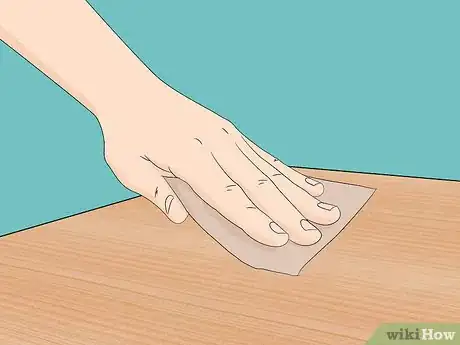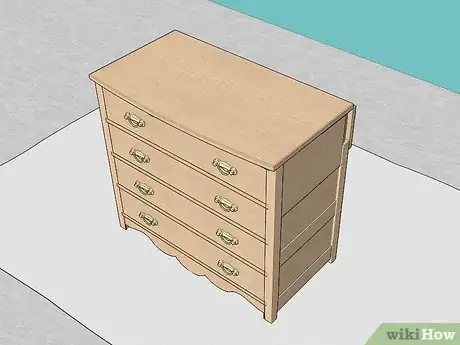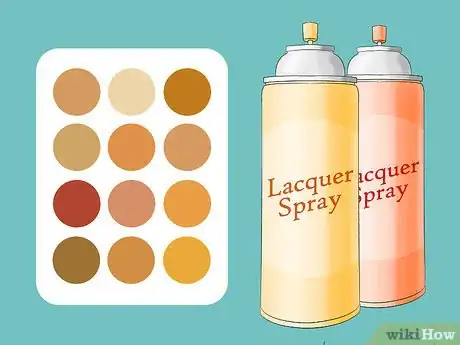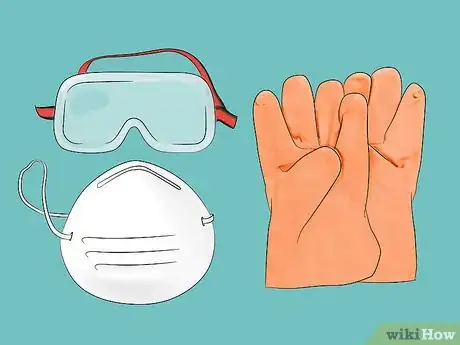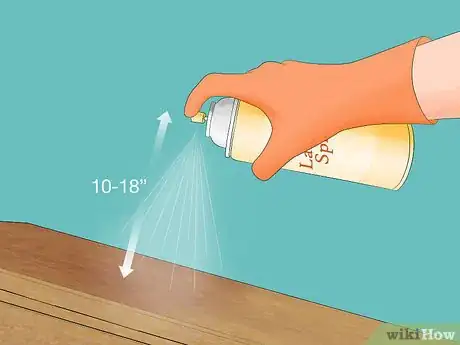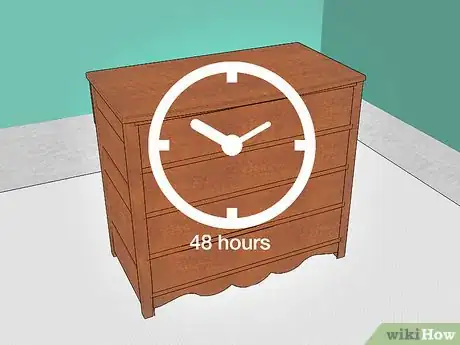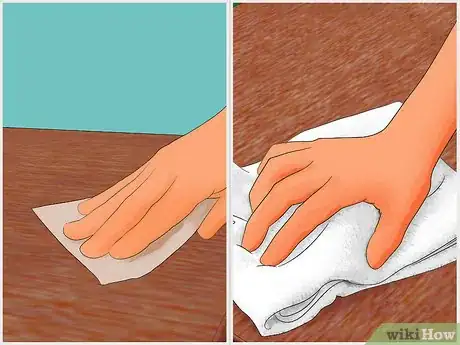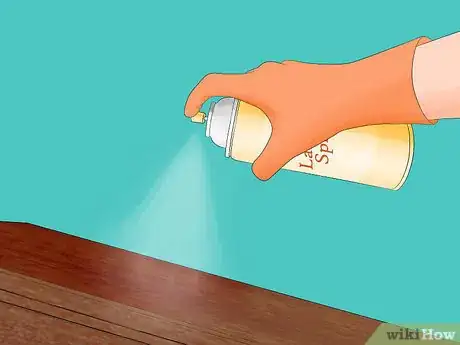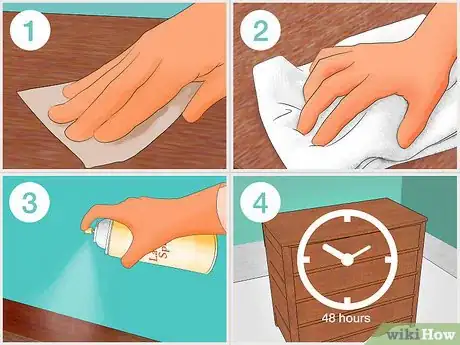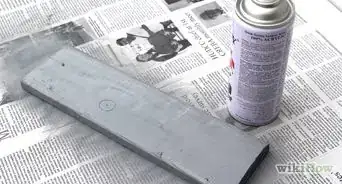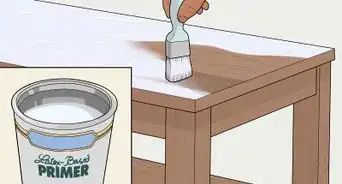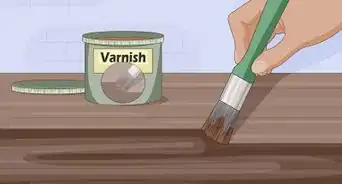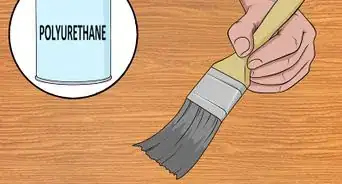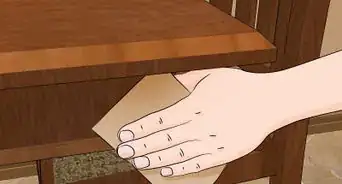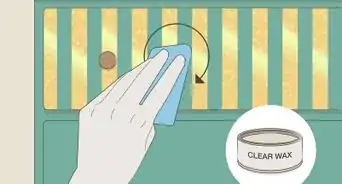X
wikiHow is a “wiki,” similar to Wikipedia, which means that many of our articles are co-written by multiple authors. To create this article, volunteer authors worked to edit and improve it over time.
There are 8 references cited in this article, which can be found at the bottom of the page.
This article has been viewed 73,955 times.
Learn more...
Lacquer is a varnish that is often used on wood to create a durable and shiny surface. A clear lacquer can be used on a natural wood surface, or you can employ a shiny colored lacquer to make furniture more noticeable. As with any furniture finish, the time you put into sanding and prepping the surface will pay off with a smooth surface.
Steps
Part 1
Part 1 of 3:
Preparing the Wood
-
1Choose the piece of furniture that you want to lacquer. If it has a rough surface, you will need to sand it first with a medium (80-grit) sandpaper until the edges are even. Employ a power sander for faster results.[1]
- Fill in any holes with lacquer filler. Regular brands of filler will not be compatible with the chemicals in lacquer.[2]
-
2Sand the surface again with extra fine (120-grit) sandpaper. The sanding will create a smooth surface but also help the primer to stick to the surface of your wood.[3]Advertisement
-
3Wipe the furniture thoroughly with tack cloths. Remove all debris before continuing. Vacuum the entire area with a shop-vac to remove excess dust before you start your finishing process.
-
4Set down clean drop cloths. Choose a very well ventilated place to apply your lacquer. Many types of lacquer are toxic and flammable.
Advertisement
Part 2
Part 2 of 3:
Applying Lacquer
-
1Purchase a lacquer base/primer. It will help the lacquer to stick more easily to the surface. If your wood has a very rough finish, do two coats of lacquer primer. Dry according to package directions in between coats.
-
2Buy cans of colored lacquer spray. Aerosol lacquer is the best product to use the first time you try the method because it can be applied uniformly.
- If you must apply liquid lacquer, use a wide natural bristle brush. Practice on another piece of wood before you finish your piece of furniture.
-
3Wear a mask, safety goggles and gloves when you apply all paint and lacquer.
-
4Sand the surface of the primer with fine-grit sandpaper. Wipe it with a tack cloth before applying your lacquer.[4]
-
5Shake the can according to package directions. Hold the can between 10 and 18 inches from the surface of the furniture. Spray it in small horizontal strokes.[5]
- If the surface starts to dimple, like an orange peel, you are holding the can too far away.
- If the surface starts to streak, you are holding it too close.
- It may take a few practice strokes to find the ideal distance for your climate and furniture.
-
6Cover the entire surface with a coat of lacquer. It will take a half hour or less to dry, but 48 hours to cure. Let each coat cure before you apply another layer.
Advertisement
Part 3
Part 3 of 3:
Applying Additional Lacquer Coats
-
1Sand the surface lightly again, with fine-grit sandpaper. Wipe with a tack cloth.[6]
-
2Apply a second coat of lacquer. Let it cure.
-
3Sand and wipe the surface. Apply a third coat of lacquer and let it cure for 48 hours. Lacquer is thinner than other finishes and requires more coats.[7]
-
4
Advertisement
Community Q&A
-
QuestionI sanded the wood thoroughly, but brushing it first created all kinds of discoloration spots. Any idea what happened and how to fix it?
 Community AnswerYou may have uncovered slightly deteriorated wood portions from your thorough sanding. Also, you may have used a rancid or old lacquer, or used a brush that wasn't thoroughly cleaned from a previous use. How to fix it would depend on the cause of the problem or how extensive it is. You could continue to sand to get all of the discoloration and putty, but the results may vary. For improper use of a tainted brush or bad lacquer, it's best to sand it again. But take it easy and/or use lacquer thinner if it's still fresh and remove the old varnish or lacquer. If it is extensive, you should consider the service of a professional, unless you have plenty of time and don't care if it comes out right or not.
Community AnswerYou may have uncovered slightly deteriorated wood portions from your thorough sanding. Also, you may have used a rancid or old lacquer, or used a brush that wasn't thoroughly cleaned from a previous use. How to fix it would depend on the cause of the problem or how extensive it is. You could continue to sand to get all of the discoloration and putty, but the results may vary. For improper use of a tainted brush or bad lacquer, it's best to sand it again. But take it easy and/or use lacquer thinner if it's still fresh and remove the old varnish or lacquer. If it is extensive, you should consider the service of a professional, unless you have plenty of time and don't care if it comes out right or not. -
QuestionHow do I mix lacquer with other finishing painting?
 Community AnswerIt is best not to mix unrelated products. Mixing most lacquers with most kinds of paints doesn't usually work well, unless the product manufacturer states that it can be done. Lacquer-based paint was used extensively in the early to mid-20th century. It is used in the auto-repair industry, however. Lacquer-based paints may be a bit difficult to work with and there is some skill and tricks involved, so practice on something that doesn't matter first.
Community AnswerIt is best not to mix unrelated products. Mixing most lacquers with most kinds of paints doesn't usually work well, unless the product manufacturer states that it can be done. Lacquer-based paint was used extensively in the early to mid-20th century. It is used in the auto-repair industry, however. Lacquer-based paints may be a bit difficult to work with and there is some skill and tricks involved, so practice on something that doesn't matter first.
Advertisement
Warnings
- Don’t use lacquer on rosewood or mahogany furniture. The oils in the wood aren’t compatible with the chemicals in the lacquer. The color will bleed.[10]⧼thumbs_response⧽
Advertisement
Things You'll Need
- Safety goggles
- Ventilation mask
- Gloves
- Drop cloths
- Shop vac
- Fine-grit sandpaper
- Sander
- Tack cloths
- Lacquer primer
- Aerosol lacquer
- No. 0000 steel wool
- Paste wax
- Lint-free cloth
References
- ↑ https://www.youtube.com/watch?v=O4v9u2f67qY
- ↑ http://tlc.howstuffworks.com/home/guide-to-furniture-finishes-ga4.htm
- ↑ https://www.popularwoodworking.com/techniques/rules_for_sanding_wood/
- ↑ https://www.thesawguy.com/how-to-lacquer-wood/
- ↑ https://www.finewoodworking.com/2007/09/24/finish-recipe-spraying-lacquer
- ↑ https://www.thesawguy.com/how-to-lacquer-wood/
- ↑ https://www.finewoodworking.com/2007/09/24/finish-recipe-spraying-lacquer
- ↑ http://www.woodcentral.com/russ/finish11.shtml
- ↑ http://tlc.howstuffworks.com/home/guide-to-furniture-finishes-ga4.htm
About This Article
Advertisement

